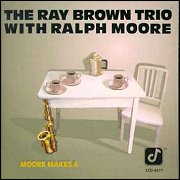This album--pairing a rising young Coltrane-inspired tenor player with the trio led by one of the all-time great bass players, a star since the emergence of bebop in the mid 1940s--had its birth in impromptu performances in places like Egypt, Taiwan, Korea, and the Soviet Union. How? Tenor saxist Ralph Moore, drummer Jeff Hamilton, bassist Ray Brown, and pianist Gene Harris were all touring the world in the Philip Morris Superband, which Harris has led for several years. In addition to the formal concerts by that big band, Moore, Hamilton, Brown, and Harris (sometimes joined by a fifth musician, such as Herb Ellis or Kenny Burrell) wound up doing informal workshops for the local musicians in countries they'd visit, Brown, Harris, and Hamilton really liked Moore's playing, and, as Moore recalls, "our relationship just grew stronger."
Brown had the idea of inviting Moore to be a guest star on his next trio date. "I wanted to see how he'd operate with a trio like mine," Brown says in typically low-key fashion. "He'd been doing a lot of really modern stuff on his own. I just wanted to see what he'd sound like with a little different type rhythm section."
Moore has high regard for all three musicians: "Ray's always been a great inspiration to me--even before I actually met him. And I used to listen to Gene Harris and the Three Sounds for inspiration, too--like, the record they did called The Blue Hour with Stanley Turrentine. I love Gene's playing. He's extremely soulful and he swings his butt off! It's an impossibility, almost, that I should be up here playing with Ray Brown and Gene Harris. And Jeff Hamilton's not just a great drurnmer--he's a great person to hang with when you're traveling. I look forward to playing with all of them again."
Brown told Moore to pick some tunes he'd like to play; they'd get together in the studio and take them. When they got together, they did just that. "Ray's a master at putting things together on the spot," Moore notes. "And he has a way of putting a different thing on each number so they don't get monotonous. That's experience."
Brown had brought along a few tunes he thought would be good for Moore, too. Some things from his youth that he could just hear Moore getting into--like "The Champ," a 1944 Dizzy Gillespie composition that Moore carries off with panache. "He's good at that, what we call 'whipping it up,'" Brown says. Brown also brought him a zesty Johnny Hodges number, new to Moore--and you can bet it's going to become part of Moore's repertoire--"Squatty Roo." "I liked the way he played that," Brown comments. Moore selected most of the romantic ballads.
The catchiest number in the collection, for my money, is a new thing called "Ralph's Boogie" [mp3]. Brown surprised Moore by devising this vehicle (sort of a funky grandchild of "It Don't Mean a Thing") especially for him. Brown recalls: "I told Ralph, 'I'm going to put you in a little bag here with a little hook on it and see if we can get you some airplay.' Because when a guy isn't known, he needs to have something that's played a lot. He needs something that everybody's going to say, 'Oh, hey!' and they'll play it every day, three or four times. And that's how you'll really get into the spotlight. So that's what I was trying to do when I wrote 'Ralph's Boogie' for him."
Perhaps the biggest surprise--and a testimonial to Brown's generosity of spirit--is that Brown turns virtually this entire album over to Moore. It becomes Moore's showcase, with the unsurpassed Ray Brown Trio serving as a kind of dream rhythm section for him. Not a lot of leaders would do this. Most would feature themselves and then bring in their guest star for a clearly subsidiary role. But Brown says: "The only way you can introduce a new guy is to let him stretch out a little bit. I mean, I can't get much more exposure than what I've had over the years. A guy like Ralph's just coming around the corner, you know. We're trying to get him out and get him going . . . And I think we got a few good things." Indeed!
--CHIP DEFFAA, from the liner notes.




